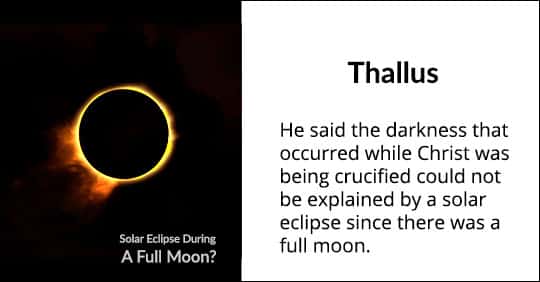Thallus’s Background
About A.D. 52, Thallus wrote a history about the Middle East from the time of the Trojan War to the first century A.D.[1] The work has been lost and the only record we have of his writings is through Julius Africanus (AD 221). Below Julius Africanus refers to Christ’s crucifixion and the darkness that covered the earth prior to his death.
Thallus Reference To Jesus Christ
“On the whole world there pressed a most fearful darkness; and the rocks were rent by an earthquake, and many places in Judea and other districts were thrown down. This darkness Thallus, in the 263 third book of his History, calls, as appears to me without reason, an eclipse of the sun. For the Hebrews celebrate the passover on the 14th day according to the moon, and the passion of our Savior fails on the day before the passover [see Phlegon]; but an eclipse of the sun takes place only when the moon comes under the sun. And it cannot happen at any other time but in the interval between the first day of the new moon and the last of the old, that is, at their junction: how then should an eclipse be supposed to happen when the moon is almost diametrically opposite the sun?” – Julius Africanus, Chronography, 18.1
Conclusion
This reference reveals several key things:
- Darkness covered the earth at Christ’s death.
- He understood that a solar eclipse could not explain the total darkness.
- The time of the darkness agrees with Matthew 27:45.
- An eclipse cannot account for the darkness – this was a miracle.
